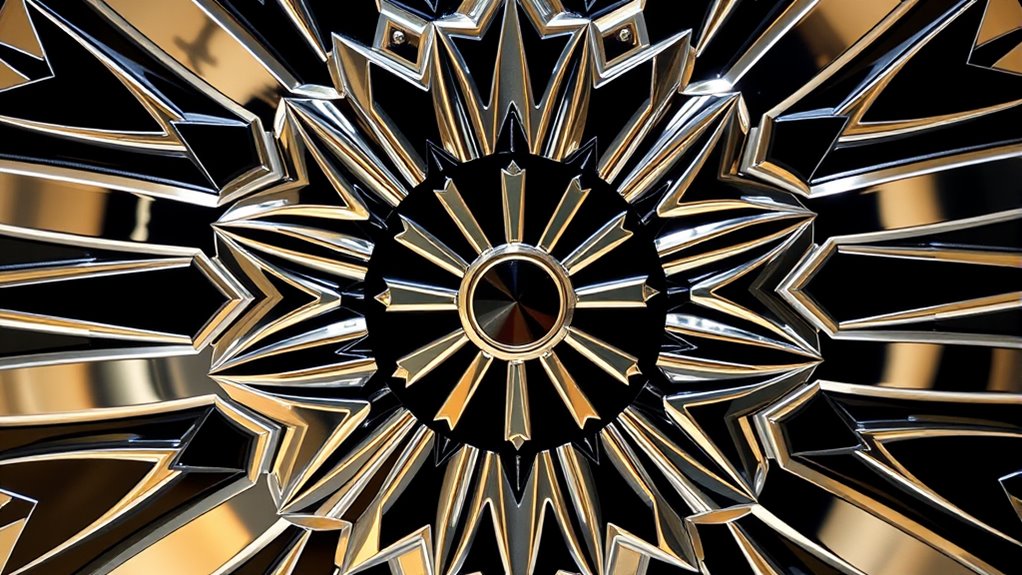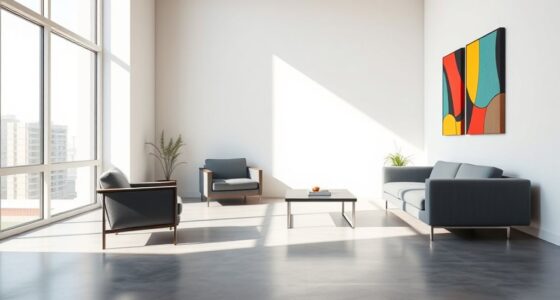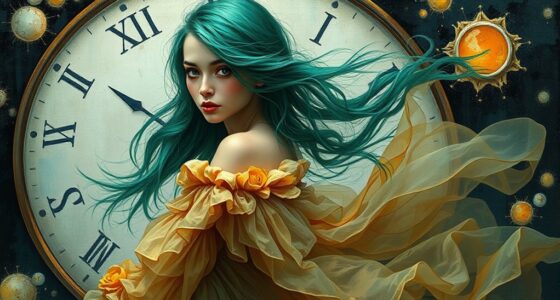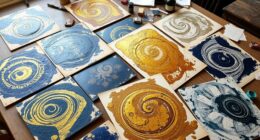Art Deco design motifs started in the early 20th century, reflecting modernity, luxury, and elegance. They emphasize geometric patterns like zigzags and chevrons, drawing inspiration from ancient Egypt, Aztec, and Mayan cultures, as well as the Machine and Jazz Ages. These motifs symbolize progress and optimism, combining organic and mechanical elements for harmony. If you explore further, you’ll uncover how these symbols continue to influence modern style and design.
Key Takeaways
- Art Deco motifs emerged in the early 20th century, emphasizing modernity, luxury, and geometric patterns.
- They drew inspiration from ancient civilizations, the Machine Age, and the Jazz Age, blending natural and mechanical elements.
- Geometric shapes like zigzags and chevrons symbolize progress and optimism, reflecting societal advancements.
- Decorative motifs serve to convey sophistication, embody technological progress, and enhance architectural grandeur.
- The style’s legacy endures, influencing modern design with its emphasis on symmetry, bold lines, and cultural symbolism.
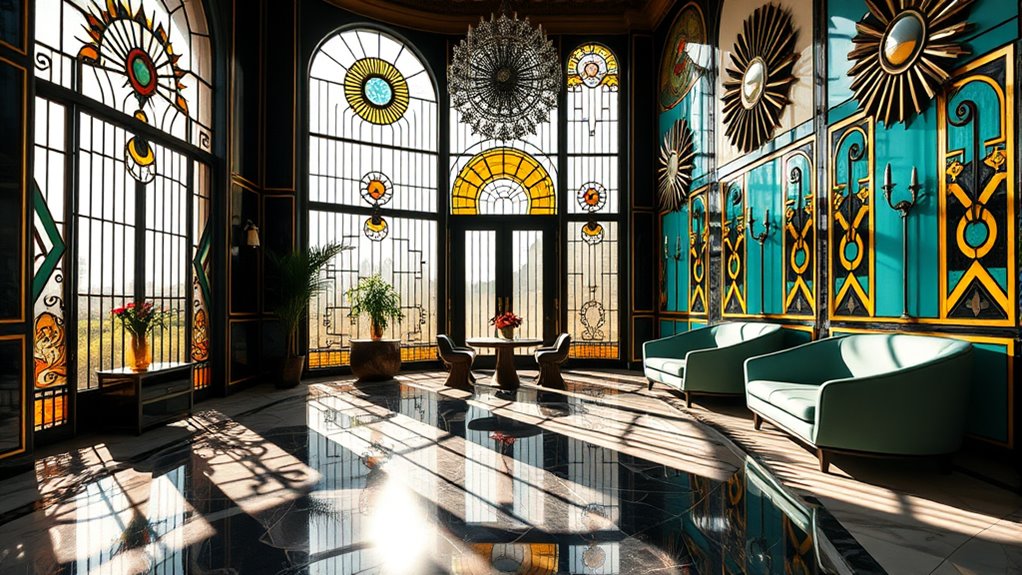
Art Deco design motifs emerged in the early 20th century, reflecting a blend of modernity, luxury, and elegance. During this period, designers and artists sought to break away from traditional styles, embracing new materials and innovative forms. Central to this movement are the distinctive geometric patterns and decorative motifs that define Art Deco’s visual identity. You’ll notice that these motifs often feature bold, symmetrical shapes—zigzags, chevrons, and stepped forms—that create a sense of rhythm and dynamism. These geometric patterns aren’t just decorative; they symbolize progress and optimism, echoing the technological advancements of the era. As you observe Art Deco architecture, jewelry, or interior design, you’ll see how these motifs serve as a visual shorthand for sophistication and modernity.
The decorative motifs of Art Deco draw inspiration from a variety of sources, including ancient civilizations like Egypt, Aztec, and Mayan cultures, as well as the Machine Age and the Jazz Age. You’ll find stylized representations of sunbursts, feathers, and lightning bolts woven into the design language, all rendered with sleek lines and sharp angles. These motifs often combine organic and geometric elements, creating a harmonious balance that feels both natural and mechanical. You might notice how the repetitive use of patterns, such as stepped forms and fan shapes, contributes to the overall sense of unity and order in Art Deco objects. This emphasis on decoration isn’t merely ornamental; it’s a deliberate reflection of the era’s fascination with progress, luxury, and the future. Additionally, the use of geometric patterns in various mediums exemplifies how Art Deco aimed to embody the spirit of technological progress.
In architecture, these motifs translate into facades adorned with stylized floral and sunburst patterns, emphasizing grandeur and elegance. In jewelry and interior decor, geometric patterns often serve as focal points, framing space with bold lines and symmetrical arrangements. You’re encouraged to look closely at the details—how the decorative motifs are integrated into the overall design—to appreciate the craftsmanship and symbolic richness that characterize Art Deco. These motifs helped establish a style that was both contemporary and timeless, blending the artistic with the industrial. They captured the spirit of a society enthusiastic to embrace innovation while celebrating luxury and artistry. As a result, the geometric patterns and decorative motifs of Art Deco continue to influence contemporary design, serving as a tribute to its enduring appeal and visionary aesthetic.
Frequently Asked Questions
How Did Art Deco Motifs Influence Modern Interior Design?
You can see how art deco motifs influence modern interior design through their bold use of art deco symbolism and geometric pattern influence. These elements bring a sense of glamour, sophistication, and structure to contemporary spaces. By integrating sleek lines, symmetrical shapes, and stylized motifs, you create environments that feel both timeless and innovative, paying homage to the elegance of the art deco era while adding a modern touch.
What Materials Were Commonly Used in Art Deco Ornamentation?
Imagine uncovering the secrets behind Art Deco ornamentation—materials and techniques that define its bold style. You’ll find luxurious materials like chrome, glass, and exotic woods, combined with intricate inlay and geometric patterns. Symbolism and motifs like sunbursts, zigzags, and stylized florals enhance its allure. These choices create a sense of glamour and modernity, revealing how craftsmanship and symbolism come together to craft timeless, mesmerizing designs.
Are There Regional Variations in Art Deco Motifs Worldwide?
You’ll notice regional variations in Art Deco motifs, reflecting local symbolism and cultural adaptations. For example, in France, you see elegant geometric patterns, while in Egypt, motifs incorporate hieroglyphic-inspired designs. In the United States, motifs often blend modernity with traditional symbols, creating unique regional identities. These differences showcase how Art Deco adapts globally, integrating local cultural elements into a cohesive style that resonates worldwide.
How Did Art Deco Motifs Evolve After the 1930S?
You might wonder how Art Deco motifs changed after the 1930s. As the world moved forward, an Art Deco revival emerged, blending vintage glamour with modern influences. Post-war reinterpretations introduced streamlined shapes and new materials, transforming classic motifs into sleek, contemporary designs. This evolution kept the style alive, echoing optimism and innovation, shaping the visual landscape for decades to come.
Which Artists or Designers Popularized Specific Art Deco Patterns?
You’ll find that influential art deco designers like Erté, Clarice Cliff, and Ruhlmann popularized specific art deco patterns, shaping the movement’s distinctive style. They drew inspiration from art deco pattern origins, blending geometric shapes, luxurious materials, and bold lines. Their innovative designs, featured in jewelry, ceramics, and architecture, helped define the aesthetic, making these motifs timeless symbols of elegance and modernity in the art deco era.
Conclusion
As you explore Art Deco design motifs, you realize their timeless appeal still influences today’s aesthetics, even amidst smartphones and space travel. You see how the bold geometric shapes and lavish ornamentation symbolize a desire for progress and glamour. Just like how vintage vinyl records have made a comeback, these motifs remind you that true style transcends eras—proving that, in design, history can be your most fashionable playlist.
